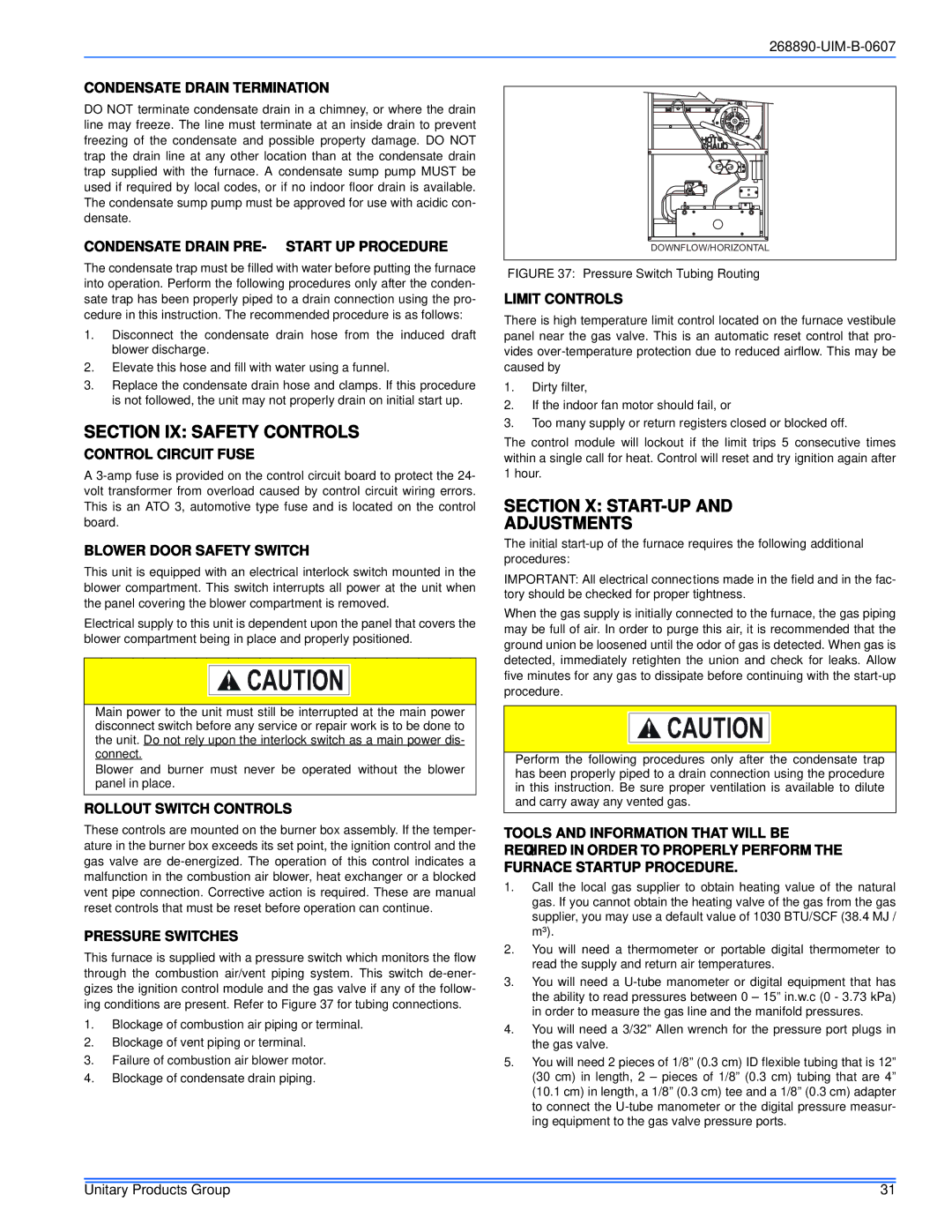CONDENSATE DRAIN TERMINATION
DO NOT terminate condensate drain in a chimney, or where the drain line may freeze. The line must terminate at an inside drain to prevent freezing of the condensate and possible property damage. DO NOT trap the drain line at any other location than at the condensate drain trap supplied with the furnace. A condensate sump pump MUST be used if required by local codes, or if no indoor floor drain is available. The condensate sump pump must be approved for use with acidic con- densate.
CONDENSATE DRAIN PRE-START UP PROCEDURE
The condensate trap must be filled with water before putting the furnace into operation. Perform the following procedures only after the conden- sate trap has been properly piped to a drain connection using the pro- cedure in this instruction. The recommended procedure is as follows:
1.Disconnect the condensate drain hose from the induced draft blower discharge.
2.Elevate this hose and fill with water using a funnel.
3.Replace the condensate drain hose and clamps. If this procedure is not followed, the unit may not properly drain on initial start up.
SECTION IX: SAFETY CONTROLS
CONTROL CIRCUIT FUSE
A 3-amp fuse is provided on the control circuit board to protect the 24- volt transformer from overload caused by control circuit wiring errors. This is an ATO 3, automotive type fuse and is located on the control board.
BLOWER DOOR SAFETY SWITCH
This unit is equipped with an electrical interlock switch mounted in the blower compartment. This switch interrupts all power at the unit when the panel covering the blower compartment is removed.
Electrical supply to this unit is dependent upon the panel that covers the blower compartment being in place and properly positioned.
Main power to the unit must still be interrupted at the main power disconnect switch before any service or repair work is to be done to the unit. Do not rely upon the interlock switch as a main power dis- connect.
Blower and burner must never be operated without the blower panel in place.
ROLLOUT SWITCH CONTROLS
These controls are mounted on the burner box assembly. If the temper- ature in the burner box exceeds its set point, the ignition control and the gas valve are de-energized. The operation of this control indicates a malfunction in the combustion air blower, heat exchanger or a blocked vent pipe connection. Corrective action is required. These are manual reset controls that must be reset before operation can continue.
PRESSURE SWITCHES
This furnace is supplied with a pressure switch which monitors the flow through the combustion air/vent piping system. This switch de-ener- gizes the ignition control module and the gas valve if any of the follow- ing conditions are present. Refer to Figure 37 for tubing connections.
1.Blockage of combustion air piping or terminal.
2.Blockage of vent piping or terminal.
3.Failure of combustion air blower motor.
4.Blockage of condensate drain piping.
DOWNFLOW/HORIZONTAL
FIGURE 37: Pressure Switch Tubing Routing
LIMIT CONTROLS
There is high temperature limit control located on the furnace vestibule panel near the gas valve. This is an automatic reset control that pro- vides over-temperature protection due to reduced airflow. This may be caused by
1.Dirty filter,
2.If the indoor fan motor should fail, or
3.Too many supply or return registers closed or blocked off.
The control module will lockout if the limit trips 5 consecutive times within a single call for heat. Control will reset and try ignition again after 1 hour.
SECTION X: START-UP AND
ADJUSTMENTS
The initial start-up of the furnace requires the following additional procedures:
IMPORTANT: All electrical connections made in the field and in the fac- tory should be checked for proper tightness.
When the gas supply is initially connected to the furnace, the gas piping may be full of air. In order to purge this air, it is recommended that the ground union be loosened until the odor of gas is detected. When gas is detected, immediately retighten the union and check for leaks. Allow five minutes for any gas to dissipate before continuing with the start-up procedure.
Perform the following procedures only after the condensate trap has been properly piped to a drain connection using the procedure in this instruction. Be sure proper ventilation is available to dilute and carry away any vented gas.
TOOLS AND INFORMATION THAT WILL BE REQUIRED IN ORDER TO PROPERLY PERFORM THE FURNACE STARTUP PROCEDURE.
1.Call the local gas supplier to obtain heating value of the natural gas. If you cannot obtain the heating valve of the gas from the gas supplier, you may use a default value of 1030 BTU/SCF (38.4 MJ / m³).
2.You will need a thermometer or portable digital thermometer to read the supply and return air temperatures.
3.You will need a U-tube manometer or digital equipment that has the ability to read pressures between 0 – 15” in.w.c (0 - 3.73 kPa) in order to measure the gas line and the manifold pressures.
4.You will need a 3/32” Allen wrench for the pressure port plugs in the gas valve.
5.You will need 2 pieces of 1/8” (0.3 cm) ID flexible tubing that is 12” (30 cm) in length, 2 – pieces of 1/8” (0.3 cm) tubing that are 4” (10.1 cm) in length, a 1/8” (0.3 cm) tee and a 1/8” (0.3 cm) adapter to connect the U-tube manometer or the digital pressure measur- ing equipment to the gas valve pressure ports.

